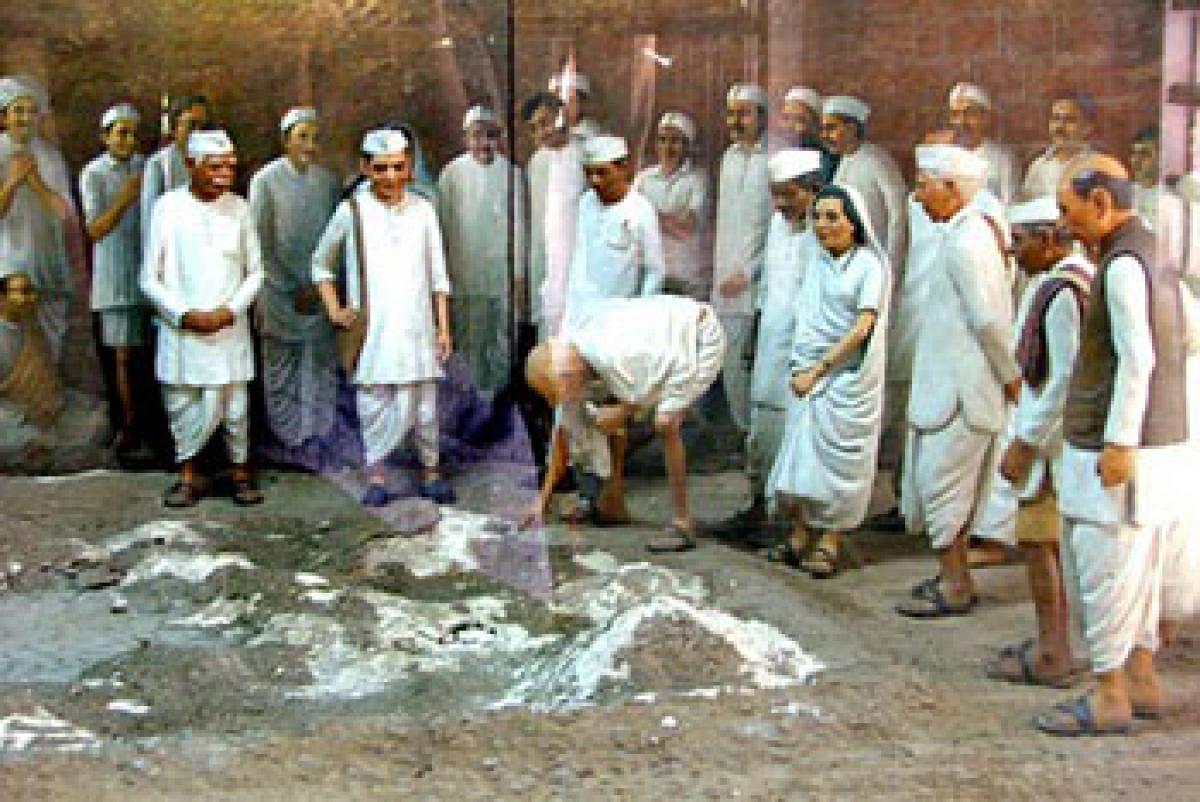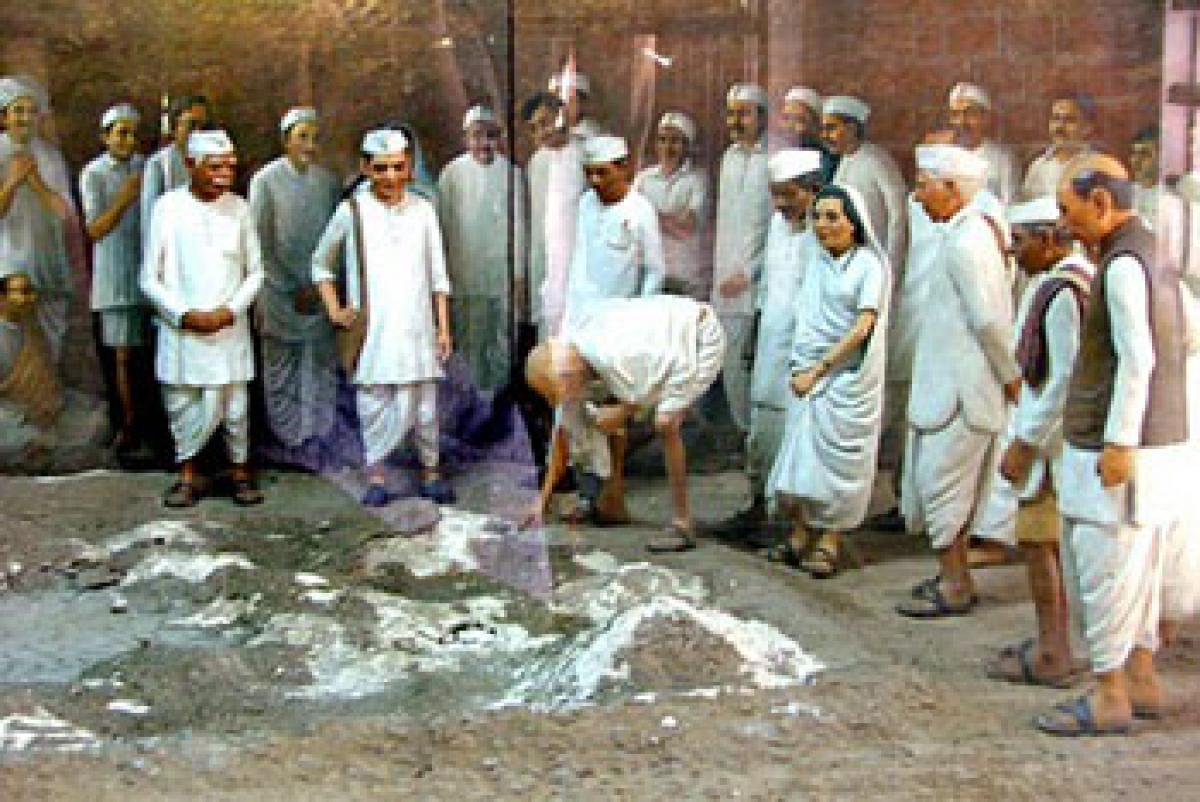Live
- Delhi’s Air Quality Hits Hazardous 500 Mark: Pollution Crisis Disrupts Life and Health
- Desist from spreading lies against survey: Ponguleti to BRS leaders
- Allu Arjun’s ‘Pushpa 2’ Breaks Records with Its Television Rights Deal
- OU Prof Arjuna Rao elected president of SIHC, VIT
- Gold rates in Hyderabad today surges, check the rates on 19 November, 2024
- Jaishankar Meets Chinese FM In Rio: First High-Level Talk Since October Border Deal
- Chinese National Arrested In Delhi For Rs 100 Crore Multi-State Cyber Fraud Operation
- Gold rates in Visakhapatnam today surges, check the rates on 19 November, 2024
- Gold rates in Vijayawada today surges, check the rates on 19 November, 2024
- Do you support caste census? Which one will you prefer caste census or skill census?
Just In

Thus, the stage was set for the second major struggle led by the Congress. On 12th March 1930, Gandhi began his famous March to Dandi with his chosen 79 followers to break the salt laws. He reached the coast of Dandi on 5 April 1930 after marching a distance of 200 miles and on 6 April formally launched the Civil Disobedience Movement by breaking the salt laws.
The Dandi March
 Thus, the stage was set for the second major struggle led by the Congress. On 12th March 1930, Gandhi began his famous March to Dandi with his chosen 79 followers to break the salt laws. He reached the coast of Dandi on 5 April 1930 after marching a distance of 200 miles and on 6 April formally launched the Civil Disobedience Movement by breaking the salt laws.
Thus, the stage was set for the second major struggle led by the Congress. On 12th March 1930, Gandhi began his famous March to Dandi with his chosen 79 followers to break the salt laws. He reached the coast of Dandi on 5 April 1930 after marching a distance of 200 miles and on 6 April formally launched the Civil Disobedience Movement by breaking the salt laws.
On 9 April, Mahatma Gandhi laid out the programme of the movement which included making of salt in every village in violation of the existing salt laws; picketing by women before the shops selling liquor, opium and foreign clothes; organising the bonfires of foreign clothes; spinning clothes by using charkha fighting untouchability; boycotting of schools and colleges by students and resigning from government jobs by the people. Over and above all these, the programme also called upon the people not to pay taxes to the government.
Soon, the movement spread to all parts of the country. Students, workers, farmers and women, all participated in this movement with great enthusiasm. As a reaction, the British Government arrested important leaders of the Congress and imprisoned them.
Round Table Conference
The British government adopted the strategy of talking to different political parties by convening the Round Table Conferences. The first Round Table Conference was held in November 1930 at London and it was boycotted by the Congress. In January 1931 in order to create a conducive atmosphere for talks, the government lifted the ban on the Congress Party and released its leaders from prison.
On 8 March 1931 the Gandhi-Irwin Pact was signed. As per this pact, Mahatma Gandhi agreed to suspend the Civil-Disobedience Movement and participate in the Second- Round Table Conference. In September 1931, the Second Round Table Conference was held at London. Mahatma Gandhi participated in the Conference but returned to India disappointed as no agreement could be reached on the demand of complete independence and on the communal question.
In January 1932, the Civil-Disobedience Movement was resumed. The government responded to it by arresting Mahatma Gandhi and Sardar Patel and by reimposing the ban on the Congress party.
The Second World War and National Movement
In 1937 elections were held under the provisions of the Government of India Act of 1935. Congress Ministries were formed in seven states of India. On 1 September 1939 the Second World War broke out. The British Government without consulting the people of India involved the country in the war.
The Congress vehemently opposed it and as a mark of protest the Congress Ministries in the Provinces resigned on 12 December 1939. The Muslim League celebrated that day as the Deliverance Day. In March 1940 the Muslim League demanded the creation of Pakistan.
The Individual Satyagraha
During the course of the Second World War in order to secure the cooperation of the Indians, the British Government made an announcement on 8 August 1940, which came to be known as the ‘August Offer’. The August Offer envisaged that after the War a representative body of Indians would be set up to frame the new Constitution.
Gandhi was not satisfied with this offer and decided to launch Individual Satyagraha. Individual Satyagraha was limited, symbolic and non-violent in nature and it was left to Mahatma Gandhi to choose the Satyagrahis. Acharya Vinoba Bhave was the first to offer Satyagraha and he was sentenced to three months imprisonment.
Jawaharlal Nehru was the second Satyagrahi and imprisoned for four months. The individual Satyagraha continued for nearly 15 months.
Cripps Mission (1942)
In the meantime, the Viceroy, Lord Linlithgow expanded his Executive Council by including five more Indians into it in July 1941. However, in the midst of worsening wartime international situation, the British Government in its continued effort to secure Indian cooperation sent Sir Stafford Cripps to India on 23 March 1942.
- This is known as Cripps Mission. The main recommendations of Cripps were:
- The promise of Dominion Status to India,
- Protection of minorities
- Setting up of a Constituent Assembly in which there would be representatives from the Princely States along with those of the British Provinces,
- There would be provision for any Province of British India not prepared to accept this Constitution, either to retain its present constitutional position or frame a constitution of its own.
The major political parties of the country rejected the Cripps proposals. Gandhi called Cripp’s proposals as a “Post-dated Cheque”. They did not like the rights of the Princely States either to send their representatives to the Constituent Assembly or to stay out of the Indian Union.
The Muslim League was also dissatisfied as its demand for Pakistan had not been conceded in the proposal.
Quit India Movement (1942-1944)
The failure of the Cripps Mission and the fear of an impending Japanese invasion of India led Mahatma Gandhi to begin his campaign for the British to quit India. Mahatma Gandhi believed that an interim government could be formed only after the British left India and the Hindu-Muslim problem sorted out.
The All India Congress Committee met at Bombay on 8 August 1942 and passed the famous Quit India Resolution. On the same day, Gandhi gave his call of ‘do or die’. On 8th and 9th August 1942, the government arrested all the prominent leaders of the Congress.
For once, this pre-planned action of the government left the Indian people without leadership. Mahatma Gandhi was kept in prison at Poona. Pandit Jawaharlal Nehru, Abul Kalam Azad, and other leaders were imprisoned in the Ahmednagar Fort.
At this time, leadership was provided by Ram Manohar Lohia, Achyuta and S.M. Joshi. The role of Jayaprakash Narain in this movement was important. Large number of students also left their schools and colleges to join the movement. The youth of the nation also participated in this movement with patriotism.
Strikes, demonstrations and public meetings were organised in various towns and cities. Slowly the movement reached the rural areas. In 1943, as the movement gained further momentum, there were armed attacks on government buildings in Madras and Bengal.
In 1944 Mahatma Gandhi was released from jail. Quit India Movement was the final attempt for country’s freedom. The British Government ordered for 538 rounds of firing. Nearly 60,229 persons were jailed. At least 7,000 people were killed. This movement paved the way for India’s freedom.
It aroused among Indians the feelings of bravery, enthusiasm and total sacrifice.
The Indian National Army
During the course of the Second World War, armed revolutionary activities continued to take place. The role of Subhas Chandra Bose towards such activities is incomparable.
On 2 July 1943, Subhas Chandra Bose reached Singapore and gave the rousing war cry of ‘Dilli Chalo’. He was made the President of Indian Independence League and soon became the supreme commander of the Indian National Army. He gave the country the slogan of Jai Hind.
The names of the INA’s three Brigades were the Subhas Brigade, Gandhi Brigade and Nehru Brigade. The women’s wing of the army was named after Rani Laxmibai. The Indian National Army marched towards Imphal after registering its victory over Kohima. After Japan’s surrender in 1945, the INA failed in its efforts. Under such circumstances, Subhas went to Taiwan.
Then on his way to Tokyo he died on 18 August 1945 in a plane crash. The trial of the soldiers of INA was held at Red Fort in Delhi. Pandit Jawaharlal Nehru, Bhulabhai Desai and Tej Bahadur Sapru fought the case on behalf of the soldiers.
The Mountbatten Plan and The Indian Independence Act 1947
Mountbatten Plan (1947)
On 20 February l947, Prime Minister Atlee announced in the House of Commons the definite intention of the British Government to transfer power to responsible Indian hands by a date not later than June 1948.
Thus, to effect the transference of that power Atlee decided to send Lord Mountbatten as Viceroy to India. Lord Mountbatten armed with vast powers became India’s Viceroy on 24 March 1947. The partition of India and the creation of Pakistan appeared inevitable to him.
After extensive consultation Lord Mountbatten put forth the plan of partition of India on 3 June 1947. The Congress and the Muslim League ultimately approved the Mountbatten Plan.
Indian Independence Act 1947
The British Government accorded formal approval to the Mountbatten Plan by enacting the Indian Independence Act on 18 July 1947. The salient features of this Act were:
- The partition of the country into India and Pakistan would come into effect from 15 August 1947.
- The British Government would transfer all powers to these two Dominions.
- A Boundary Commission would demarcate the boundaries of the provinces of the Punjab and Bengal.
- The Act provided for the transfer of power to the Constituent Assemblies of the two Dominions, which will have full authority to frame their respective Constitutions.
The Radcliff Boundary Commission drew the boundary line separating India and Pakistan. On 15th August 1947 India, and on the 14th August Pakistan came into existence as two independent states. Lord Mountbatten was made the first Governor General of Independent India, whereas Mohammad Ali Jinnah became the first Governor General of Pakistan. The most tragic incident occurred on 30 January 1948, when Mahatma Gandhi – the father of the nation on his way to a prayer meeting was assassinated by Nathuram Godse.
Source: http://holisticthought.com

© 2024 Hyderabad Media House Limited/The Hans India. All rights reserved. Powered by hocalwire.com







